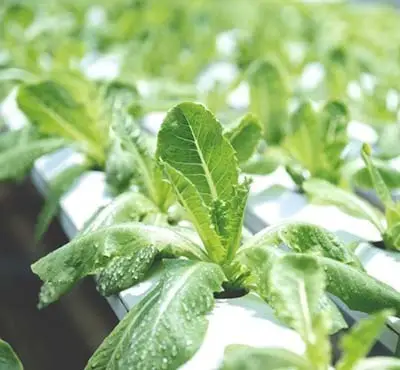Hydroponically, lettuce is the most accessible leafy greens to grow. They are great hydroponic plants for beginners to start with and used in so many hydroponic operations because of this. A hydroponic lettuce plant has a fast germination rate, occupies little space, and can be maintained easily. Find out how to grow lettuce hydroponically here!
How To Germinate Lettuce Seeds
To germinate your lettuce seed, we prefer rapid germination plugs. The best way to ensure a successful seedling is to sow a few seeds, thin them, and keep the healthiest ones. During the germination period, keep the seeds in moist conditions. Sprouting takes a few days.
The heads of the several lettuce seedlings need to be pinched off when they reach the top of the starter cube. Be sure not to pull on the seedling, or you will disrupt its root system. Once the baby lettuce has four to six mature leaves, and its roots are poking out of the bottom of the growing medium, plant it in its permanent location.
What is the best hydroponic system for lettuce?
 Hydroponic lettuce can be grown in a variety of systems. Commercially, the nutrient film technique (NFT) is the primary method. The deep water culture and raft systems are most commonly used for home hydroponic gardening. In some cases, growers use an air pump to aerate the hydroponic solution and a water chiller to cool it to an optimal temperature. Our hydroponic lettuce gardens utilize various methods, including water culture on a smaller scale, ebb and flow, and NFT systems. Avoid using a metal container as a nutrient reservoir.
Hydroponic lettuce can be grown in a variety of systems. Commercially, the nutrient film technique (NFT) is the primary method. The deep water culture and raft systems are most commonly used for home hydroponic gardening. In some cases, growers use an air pump to aerate the hydroponic solution and a water chiller to cool it to an optimal temperature. Our hydroponic lettuce gardens utilize various methods, including water culture on a smaller scale, ebb and flow, and NFT systems. Avoid using a metal container as a nutrient reservoir.
Hydroponic lettuce: What’s The Right Temperature?
Lettuce loves cooler environments. It’s crucial to maintain an ideal temperature range of 45 to 70 degrees is ideal, going from warmer to cooler during the day. The hydroponic lettuce will bolt if the ambient temperature exceeds 70 degrees, which means it will enter the flowering phase of its life cycle. The bitter taste of bolted lettuce makes it not very suitable for eating.
Spacing Requirements For Lettuce
There are different spacing requirements for different varieties. About six or eight inches apart seemed to be ideal for most of our gardens. Those with loose leaves can be put together a few inches closer together. If the head of lettuce becomes firm, it should be spaced approximately 12 inches apart to develop fully. Lettuce has shallow plant roots, so it does not need a deep grow bed to grow.
Does Hydroponic Lettuce Require Much Light?
A light source is not as crucial as its duration or intensity for varieties of lettuce to grow. The light intensity for hydroponic lettuce should be between 10 and 14 hours of light per day. As lettuce does not require intense light, you have a variety of artificial lighting options. Because of the affordable initial investment, low power consumption, and low heat production, fluorescent light is often used by those growing hydroponic lettuce.
Hydroponic Lettuce Nutrient Requirements
Lettuce needs an NPK-ratio specific to the vegetative phase. Since lettuce doesn’t need to flower to be consumed, you can use the same hydroponic nutrients until harvest. Unlike many hydroponic crops, lettuce thrives on nutrient solutions higher in nitrogen or phosphorus. It has less need for potassium. According to the instructions, when the plants have emerged, water them with a dilute hydroponic nutrient solution.
Harvesting Lettuce
You can harvest lettuce crops after a certain number of days, depending on a couple of factors. Your type of lettuce will determine what type of growing you are doing. Bib lettuce and loose-leaf lettuce can take 45-55 days to grow. It can take between 65 and 85 days for Romaine lettuce.
In addition, there are preferences to consider. You can control both the environmental conditions and the harvest by growing indoors. You can harvest individual leaves from lettuce crops without removing the entire head, unless you’re growing crisphead lettuce, such as iceberg. After harvesting the outer leaves, you can let the plant grow back before harvesting again when you’re ready to eat. In lettuce harvesting, this is referred to as “cut and come again.”.

